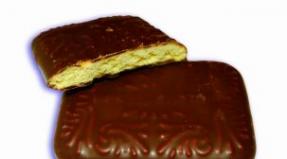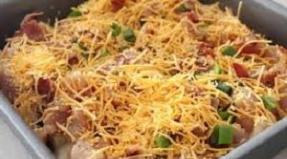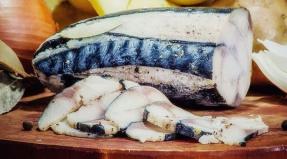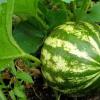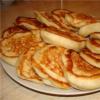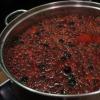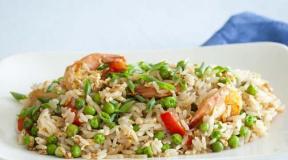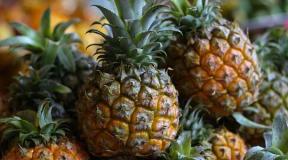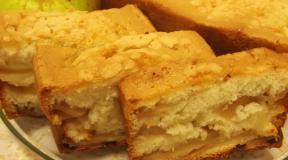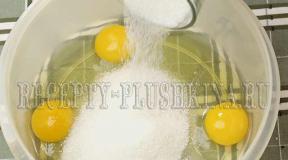Types of flour products of the 1st grade. Difference between premium flour and first grade flour
Flour, which is sold in stores, most often belongs to the highest or first grade. What is the essence of such a classification?
What is premium flour?
This product is fairly easy to identify by touch. The fact is that if you take premium flour and grind it between your palms or fingers, it will be distributed over their surface in a very thin layer, like powder. This is due to the fact that there are practically no grains in the corresponding product. The particle size of the premium flour does not exceed 40 microns. There is almost no fiber in the structure of this product, as well as elements of grain casings.
Flour of the highest grade- white, sometimes with a creamy shade. This product is ideal for baking bread as it gives it a large volume and uniform porosity. Flour of the highest grade is also used in the manufacture of various types of dough, as an element of sauces and dressings.
It should be noted that baked goods based on the product in question are high in calories. Eating large amounts of high-grade flour-based breads and buns can lead to excess weight gain. In addition, the gluten contained in flour slows down digestion, as a result of which the body does not effectively absorb vitamins, which, at the same time, are contained in significant quantities in the product in question.
Bakery products made from premium flour quickly turn stale. Therefore, it is advisable to eat them as fresh as possible.
What is first grade flour?
The considered type of flour, like the first product, is very soft to the touch, has a white color - but with a slight yellow tinge. The flour of the first grade is also ground very finely: its particle size does not exceed 60 microns.
The product in question also contains a fairly large percentage of gluten. This predetermines the possibility of manufacturing based on flour of the first grade very flexible dough, from which you can bake bulky bread and rolls of stable shape.
The taste qualities of bakery products based on the considered flour are also very high. It is recommended to use this product for baking uncomfortable types of products - for example, pies, pancakes, dumplings, some types of pasta.
Bakery products made from this type of flour are slightly less nutritious and stale more slowly than products made from premium products.
The fineness of the premium flour is approximately one and a half to two times higher than the corresponding indicator characterizing the product of the first grade. The ash content of the premium flour is about 0.55%, while the first is about 0.75%.
Comparison
We can, of course, distinguish more than one difference between the premium flour and the first grade flour. The difference between them can be traced:
- in colour;
- in the limiting particle size;
- in size;
- in ash content;
- in calories;
- in application;
- in the influence on the callousness of bakery products.
There are quite a few parameters for comparing the products in question. Let's try to more clearly display the difference between premium flour and first grade flour in a small table.
table
| Flour of the highest grade | First grade flour |
| What do they have in common? | |
| Both types of flour are soft to the touch, contain almost no elements of grain shells | |
| What is the difference between them? | |
| Has a white color, usually with a creamy tint | Is white, usually with a yellow tint |
| Particle size limiting - 40 microns | Particle size limit - 60 microns |
| Has half the size | Has twice the size |
| Has an ash content of the order of 0.55% | Has an ash content of the order of 0.75% |
| More calories | Less calories |
| Especially good for baking bread, pastries | Especially good for making uncomfortable items |
| Breads and rolls made with premium flour stale faster | Breads and rolls made from first grade flour stale more slowly |
Flour and its classification. Choose a unique type of product for an interesting and unusual dish! Flour is the product that is obtained after grinding grain products into powder.
In this case, it is possible to separate the bran or not. This product is different, both in classification and in the raw material from which it is prepared.
If we talk about flour from various raw materials, then it can differ in different properties, which requires a separate article. But now we will figure out what kind of flour is, varieties, types, classification of different varieties, based on raw materials, as well as methods of obtaining it.
Grinding, what is it like?

Any product, regardless of the raw material, is obtained in various ways. So the flour at the exit is obtained with its own special characteristics. Today the food industry divides flour into the following types:
1. Fine grinding is obtained from grain, previously cleaned of bran, shells and aleurone layer. Wheat flour is then divided into grades and types;
2. Medium grinding retains the fiber with the shell of cereals. Of course, it is very useful for our body, but its use in cooking is limited. For example, it will not be easy for you to make homemade pasta or bakery products from it;
3. Coarse grinding (wallpaper flour) contains practically all those components present in the grain culture from which this product is made. This is the most useful product for the body, because it contains vitamins and minerals, as well as other useful substances. Such flour has the form of crushed grain, which has not passed sifting. Only cereals are coarser than this product.
Another coarse product is called whole grain flour. In essence, these concepts are practically the same, but these terms are used in different cases. When we talk about wholemeal flour, we mean the type of product. Whole grain, on the other hand, speaks of a method of obtaining when the components of the grain are not removed.
Do you use a coarse-grained product in cooking to prepare a dish? Believe me, it will not only be tasty, but also healthy. For example, cornmeal can be used to make delicious pancakes. To do this, you need to take 2 tbsp. l. flour, egg, fat-free cottage cheese, about 60 g, a teaspoon of sugar and a little spices.
Mix all the ingredients, just add flour at the very end, the consistency should resemble thick caramel. Then simply fry in vegetable oil, like ordinary pancakes. You will definitely like this recipe.
Properties of flour, what can they be?

You can use general indicators used to evaluate any type of flour or special methods to determine the quality of a particular type and type of product. General quality indicators are:
- color, smell and taste;
- humidity and zoning;
- the type of grinding and the amount of impurity content;
- the amount of metal impurities and pest infestation;
- acidity;
- no crunch during chewing.
In the event that flour for these organoleptic indicators did not pass the standard requirements, then it is not used in the food industry, so further evaluation of such a product is not carried out.
Moisture is one of the most important indicators of flour quality. A product that is made from good quality grain and stored under the right conditions should have a moisture content of 13-15 percent.
In no case is the contamination of products with pests allowed in accordance with the current standards. But special indicators for determining the quality of flour are used in order to understand what consumer (that is, commercial and technological) properties it has.
The main indicators that characterize the baking properties of the product are the quality and quantity of the gluten content, the gas-forming and gas-retaining properties of flour.
It is impossible to bypass such an indicator as the type of flour - this is the most important classification category of products. The type of flour can be established only by aggregate indicators - grinding coarseness, ash content, organoleptic properties.
Flour varieties

Today, there are many types of flour. If you really try to describe them all, you will have to travel around the world. Have you been to some exotic country? Have you tried local dishes made from an unusual type of flour there? But in our country, various types of flour are used in cooking.
Wheat flour
The most popular, more than 70% of it is produced in our country when compared with other types of products.
There are several varieties of this type of product:
- grains;
- the highest grade;
- first grade;
- second grade;
- wallpaper flour.
Rye flour
Not as common as the one described above, but still quite popular. In ancient times, it was rye that dominated, because this culture was more widespread and popular in our country than wheat.
Corn flour
It is one of the young species, since it came to Europe only after America was discovered.
Buckwheat flour
The most popular is as a dietary product, as well as in the countries of the East.
Oat flour
Used almost exclusively in cooking. Do you know interesting and unusual recipes from such a product?
Rice flour
It is very common in the countries of Southeast Asia and China. It is very nutritious, but it can cause vitamin deficiency or metabolic disorders.
Flaxseed flour
It is rather not a food product, but a medicinal one. It is very nutritious and especially healthy, but it is worth mentioning that the price is high. It has various prophylactic and medicinal properties.
Almond flour
It is widely used in cooking. It is a product obtained from ground nuts and is used to prepare pralines and marzipans.
Amaran flour
A very exotic variety of flour is Amaran, which is produced in South America or East Asia. Amaranth is an ancient vegetable culture, in our country it practically does not occur, only as an exception.
Bird cherry flour
Casseroles, pies, and muffins are made from it. But, it is worth saying that buns and even bread can be made from such flour. And now I will share with you a recipe on how to make flour at home from bird cherry. You are interested?
Then pick off the brushes of bird cherry berries and dry them in the oven at a temperature of 40-50 degrees. When they are dry, then separate only the berries from the twigs. Grind the berries in a coffee grinder or blender.
Pumpkin flour
It is very useful and is used mainly for the preparation of dietary meals.
Peanut flour is made from leftover peanuts that have been squeezed into butter. It is a gluten-free alternative to a wheat product.It is used in cooking to enhance the flavor of a dish. Also, peanut flour is used to make sauce, bread, noodles, as well as bread.
Cedar flour
The most valuable product during the processing of pine nuts is pine flour. It has a light cedar aroma and whiteness, has a sweetish taste.
Hemp flour
It contains chlorophyll - it is an analogue of human hemoglobin, only plant. This product also contains fiber, it slows down the absorption of not only excess sugar, but also fat.
Sesame flour
Useful for our body, due to its mineral and vitamin composition, it also contains a very large amount of calcium. It also helps in the treatment of gastrointestinal diseases, as well as cardiovascular problems.
Wheat germ flour
Possesses very useful properties. This is a unique product if you look at its chemical composition. There is a very large vitamin and mineral complex here.
Milk thistle flour
If we are talking about milk thistle seed meal, then we must say that this is an excellent tool that takes care of your liver. Indeed, it contains silymarin, which changes the cell membrane of the liver, which prevents harmful substances from destroying this organ. You can buy it in pharmacies and specialty stores or departments where seasonings are sold.
What kind of flour should you choose?

Of all types of flour, each culinary specialist or chef decides which type to buy for him and what to cook from such a product. If you do not know where to buy the required product, then you can be advised to go to the Magazinmasla.ru website and choose the appropriate product.
Here you will find only high quality and natural products. Even flours such as amaranth or bird cherry are sold here. So that shop is sure to be your favorite if you love baking and other culinary delights.
Wheat is, without exaggeration, the most important cereal crop for humanity. It is grown on almost all continents, and dishes from this product or with its use are in the cuisine of every nation in the world. In some dishes, grains are used whole or crushed, but most often they are finely ground. What are the varieties, properties and calorie content of wheat flour? Is this product useful or not? Let's figure it out.
Flour variety
Depending on the grains used, the coarseness of the grind and the processing methods, different varieties are distinguished. There are quite a few of them, and they differ slightly in different countries. But there are basic ones that are found almost everywhere:
4. Whole grain wheat flour appeared on the shelves of stores in the post-Soviet space not so long ago. It is obtained by grinding grain without removing any particles, so it is coarse and contains a lot of bran. On an industrial scale, this variety is not very popular, because its shelf life is two times lower than, for example, that of the higher one, and the dough turns out to be heavy and not very convenient to use for large bakeries. But homemade wholegrain bread is very tasty and healthy.

Calorie content of wheat flour
Health, slim, toned bodies and balanced nutrition are in vogue today. That is why many are very interested in the question of the calorie content of wheat flour. This figure fluctuates depending on the varieties, although the difference is insignificant.
Highest - 335 kcal.
The first is 330 kcal.
The second is 320 kcal.
Whole grain - 300 kcal.
These data are approximate and cannot be accurate to one, since the calorie content of this product varies slightly depending on the method and degree of processing, storage method and even the place of cultivation.

Huge benefit
Different varieties of wheat flour also differ in the content of vitamins, micro- and macroelements. Moreover, the coarser the grinding, the "lower" the grade, the more nutrients the product will give the body.
Whole grain flour tops the list. It is very rich in vitamins B, E and PP, and also contains such vital substances as calcium, potassium, magnesium, phosphorus, iron and sodium and many others. This variety can be eaten even by those who are contraindicated. For example, with diseases such as obesity, diabetes and hypertension.
Second-grade flour is slightly inferior in terms of benefits. Although it also contains a lot of vitamins E, B and PP, as well as micro- and macroelements, metals.
Flour of the first grade has useful properties about one and a half to two times lower than the one discussed above. It is not as rich in iron, phosphorus, magnesium, potassium and calcium.
The poorest in terms of the content of the elements necessary for the body is wheat flour of the highest grade. Beautiful color, texture and taste are the result of significant processing, during which the naturalness and usefulness of the product are lost. Of course, something still remains, but in small quantities.
It should also be noted that flour is rich in fiber, which is essential for the body to function properly. The situation with this substance is similar - the more processing, the lower the content.
A spoon of tar
The high calorie content of wheat flour is not the only disadvantage of this product. Do not forget about the content of a large amount of so-called gluten, due to which particles stick together when preparing dough or various dishes. This substance is not always well absorbed and processed by the body, and its excess can cause problems in the digestive tract.

It is worth refusing completely from flour products only with the strict prescription of doctors. It is not worth depriving yourself of this product of your own free will. The main thing is to choose the right variety and know when to stop.
If healthy whole grain flour does not taste good and does not generate enthusiasm by itself, then you should try mixing it with other types of wheat flour. There are also many recipes with the addition of different grains - rice, rye, buckwheat, etc. By experimenting, you can find your balanced product - both healthy and tasty.
Peeled rye bakery flour GOST 7045-90
Flour - the most important product of grain processing. It is obtained by grinding grain and classified by type, type and grade.
Flour type is determined by the grain crop from which it is obtained. Distinguish between wheat, rye, barley, oatmeal, rice, pea, buckwheat, soy flour. Flour can be obtained from one culture and from a mixture of wheat and rye (wheat-rye and rye-wheat).
Flour grade is the main quality indicator of all its types and types. The type of flour is related to its yield, that is, the amount of flour obtained from 100 kg of grain. The flour yield is expressed as a percentage. The higher the flour yield, the lower its grade.
For the production of bread and bakery products, bakery enterprises use mainly wheat and rye flour. Wheat flour is produced in five grades in accordance with GOST R 52189-2003.
Wheat bakery flour: grit, of the highest, first, second grades and wallpaper, or four grades according to TU 8 RF 11-95-91.
Wheat flour: of the highest, first, second grades and wallpaper.
Baking rye flour is produced in accordance with GOST 7045-90 of three varieties, seeded, peeled, and wallpaper.
Flour obtained from grain and cereal crops is used as part of composite mixtures.
Chemical composition of flour determines its nutritional value and baking properties. The chemical composition of flour depends on the composition of the grain from which it is obtained and the type of flour. Higher grades of flour are obtained from the central layers of the endosperm, therefore they contain more starch and
with less proteins, sugars, fat, minerals, vitamins, which are concentrated in its peripheral parts.
Particle size. The size of flour particles is of great importance in bakery production, significantly influencing the rate of biochemical and colloidal processes in the dough and, as a result, affects the properties in the dough, the quality and yield of bread.
Flour quality standards. Flour quality indicators are color, smell, taste, content of metal-magnetic impurities, moisture content, ash content, size, wet gluten content, acidity, water absorption capacity and ab  tolytic activity.
tolytic activity.
Flour color must correspond to its grade, however, the difference in color in batches of flour of the same grade may have for the quality of the bread.
Flavor of flour slightly sweetish, not sour and not bitter, crunch in flour should not be felt
The smell of flour specific, weak. Musty or other abnormal odor is not allowed.
Flour moisture should not exceed 15%, otherwise free moisture will appear in the flour, conditions are created for the activation of enzymes and the development of microorganisms, which can cause spoilage of the flour. The basic moisture content of flour is 14.5%. The moisture content of the flour affects the yield of the bread and the amount of water for kneading the dough.
Ash content of flour - the main indicator of its grade. Mineral substances are not evenly distributed in the grain. The ash content of the shells and the aleurone layer is 7-8.5%, and the pure endosperm is 0.4-0.45%. Therefore, in the flour of the highest grades, there is less ash than in the lower ones. The norms for the ash content of flour of the highest, first and second grades of wheat flour, respectively, are 0.55%, 0.75% and 1.25% on dry matter.
Flour size characterize the size of its particles. The higher the grade of flour, the smaller its particles. The size of the flour affects its baking properties. Large particles swell slowly and are difficult to react with enzymes and microorganisms.
Acidity of flour affects the acidity of the finished product and characterizes the freshness of flour. It is due to the presence in flour of free fatty acids, acidic salts of phosphoric acid and, to a lesser extent, other substances that have an acidic reaction of free fatty acids to gluten proteins and enzymes.
Long-term storage of flour in unfavorable conditions can lead to its deterioration: self-heating, mold, rancidity, infection with harmful insect pests. Unfavorable storage conditions are high temperature and humidity, wet sacks of flour, unsanitary condition of the warehouse.
The standards for bakery flour provide for the determination of organoleptic indicators: taste, color, smell, crunch, infestation and contamination of grain stocks by pests in accordance with GOST 27558 and GOST 27559, as well as physical and chemical indicators: moisture, ash content, particle size, content of metal-magnetic impurities, autolytic activity : for wheat flour - determination of the quantity and quality of gluten.
Ash content, flour particle size, flour whiteness at bakeries, as a rule, are not controlled. In addition to standard indicators of flour quality, acidity and its baking properties are determined.
 The storage of flour is provided in bulk in a closed warehouse. The warehouse for bulk storage of flour is equipped with silos of the XE-160A brand (pos.) With a capacity of 30 tons each. The stock of flour in the warehouse must be 7 days of operation of the enterprise. It is necessary for the smooth operation of the control enterprise
The storage of flour is provided in bulk in a closed warehouse. The warehouse for bulk storage of flour is equipped with silos of the XE-160A brand (pos.) With a capacity of 30 tons each. The stock of flour in the warehouse must be 7 days of operation of the enterprise. It is necessary for the smooth operation of the control enterprise  flour quality and ripening. The warehouse must be dry, clean, heated and well ventilated. The temperature in the flour warehouse should not be lower than + 8 ° C - + 10 ° C, the relative humidity should not exceed 70-75%.
flour quality and ripening. The warehouse must be dry, clean, heated and well ventilated. The temperature in the flour warehouse should not be lower than + 8 ° C - + 10 ° C, the relative humidity should not exceed 70-75%.
Flour from a car truck is fed into the silo for storage through a flexible hose through an intake flap of the KhshchP brand (item 1) through individual pipelines with the help of compressed air. In silos XE-160A (pos. 2) flour settles, and the air transporting it comes out through self-shaking filters XE-161 (pos. 3) and is cleaned of flour residues. To prevent flour caking, silos should be equipped with aerating devices. From silos with the help of a rotary feeder M-122 (pos. 4) flour is fed through pipelines for sifting.
To prepare flour for production, two sieving lines are installed in the sifting department of the bakery, each of which consists of the following equipment:
Cyclone - unloader (pos. 6)
Sifter (pos. 7)
Collector above the scales (pos. 8)
Scales automatic portion DM-100 (pos. 9)
Suspended collector (pos. 10)
Screw feeder PShM (pos. 15)
The flour is sifted, cleaned of ferro-impurities, weighed and, with the help of a screw feeder PShM (pos. 15), is fed through a pipeline to the production bunkers, a stock of flour, in which it should ensure the operation of the kneading machines for 1 - 2 shifts.
To prepare and supply compressed air to the feeders, the installation of the following equipment is provided:
Compressor 2VD-12/2 (pos. 11)
Oil separator OMM (pos. 12)
Air collector B-2 (item 13)
Air cleaner HVO-6 (pos. 14)
For bulk storage of flour, a room is provided for storing flour in bags (pos. 17, pos. 18) in the amount of a daily supply. Flour bags are stacked on pallets in "tees" or "quintuples", eight rows high. The distance from the floor must be at least 15 cm.
Nutritional value and composition of flour
Flour contains a large amount of vitamins B, PP, H, E, and the chemical composition is rich in almost all minerals necessary for the normal development of the body:
- potassium, calcium, sodium, magnesium, iron, phosphorus;
- chlorine, aluminum, titanium, nickel, tin;
- iodine, copper, chromium, molybdenum, zinc, boron, selenium, etc.
I would like to note that in the highest grades of flour there are practically no vitamins, but the low grades contain the whole complex of vitamins and microelements.
Flour from ancient times to today is one of the staples in every kitchen, from which the hostess can prepare many varieties of dishes. Flour of the first grade contains no more than 3-4% of the grain shell. This is the most beloved and widespread variety of the product. It is white with a yellowish tinge. Its content contains a third of gluten, it makes wonderful rich and not rich baked goods that do not stale for a long time.
Sort and types of flour
Wheat flour is divided into different varieties, according to the size of the grind.
This is the most common type of flour from which housewives prepare many dishes and pastries. Flour of the first grade is white in color with a yellowish tinge. This type of flour contains starch - 75%, protein - 15%, crude gluten - 30%, sugar - 2%, fat - 1%, fiber - 3%. This flour contains vitamins PP, H, B1, B12, B2, B9, and the mineral composition contains zinc, chlorine, magnesium, sodium, iron, sulfur.
100g of 1st grade flour contains:
- Water - 14.
- Proteins - 10.6.
- Fats - 1.3.
- Carbohydrates - 73.2.
- Kcal - 329.
Flour of the first grade is well suited for baking pancakes, pies, rolls, etc., but not very well for high-quality varieties of bread and confectionery (for this purpose, premium flour is needed).

This flour contains bran and crushed grain shells: gluten - 25%, starch - 70%, protein - 15%, sugar - 2%, fat - 2%, fiber - 0.7%. The color of this type of flour is from yellowish to gray and brown. Baking made from this flour turns out to be aromatic, porous, but not fluffy. Gingerbread and cookies are made from it. Also flour of the second grade is suitable for pancakes, dumplings, dumplings and baking diet bread with the addition of rye flour. The flour of the 2nd grade contains more vitamins and microelements. These are vitamins of group B, H, E, A, and the chemical composition includes:
- magnesium, potassium, iron, sulfur, phosphorus;
- zinc, vanadium, manganese, molybdenum, copper, chromium, cobalt.
100g of 2nd grade flour contains:
- Water - 14.
- Proteins - 11.7.
- Fats - 1.8.
- Carbohydrates - 70.8
- Kcal - 328.
Baking made from 2nd grade flour is much healthier and richer in vitamins and microelements than 1st grade flour.

Favorite variety of housewives. The pastries made from it are fluffy, soft, tasty. It has more fat and starch is almost absent. The color of this flour is snow-white. Flour contains proteins - 10%, crude gluten - 28%, fiber - 0.15%, fat - 0.15%, sugar - 0.15%. There are fewer vitamins than in the previous varieties: vitamins B1, B2, B9, PP, a little E and A. Trace elements contain potassium, sodium, magnesium, phosphorus, sulfur, molybdenum, chlorine.
100g of premium flour contains:
- Water - 14.
- Proteins - 10.3.
- Fats - 0.9.
- Carbohydrates - 74.2.
- Kcal - 327.
Flour of the highest grade is ideal for culinary products, puff, shortcrust and yeast dough.
Flour grit
Has a light cream shade and a high percentage of gluten. Possesses high baking properties. This type of flour is used for yeast dough with a high sugar and fat content (buns, cakes). Products made from this type of flour have poor porosity and stale quickly.
Whole wheat flour
Coarse and non-uniform in particle size. Flour contains crude gluten - 20%, has a high sugar-forming ability and moisture capacity. This type of flour is used for baking table breads.
The benefits and harms of eating flour
Benefit. The consumption of flour speeds up the metabolism, protects the cardiovascular system, stimulates the brain, stimulates the production of estrogen, and helps to cure Alzheimer's disease and osteoporosis. The use of this product reduces the risk of gallstones.
Flour helps in the treatment of asthma, bronchitis, prevents the formation of free radicals. The ingredients that make up the flour soften the inflammatory processes in the human body.
Harm. Flour is a high-calorie product, so its excessive consumption can cause obesity, increased blood pressure and allergies.
The judicious use of flour-based products will bring true delight in taste and aroma. After all, traditional tea drinking is never complete without flour-based products, and there are a lot of them: for all tastes and preferences.
Read also ...
- Recipes for making coffee with ice cream at home
- Strawberry panna cotta - a classic of world culinary What is panna cotta with strawberries
- Cream of curd cheese for cake - the best recipes for impregnating and decorating dessert
- Profiterole recipe and three original custard recipes Protein cream for profiteroles
